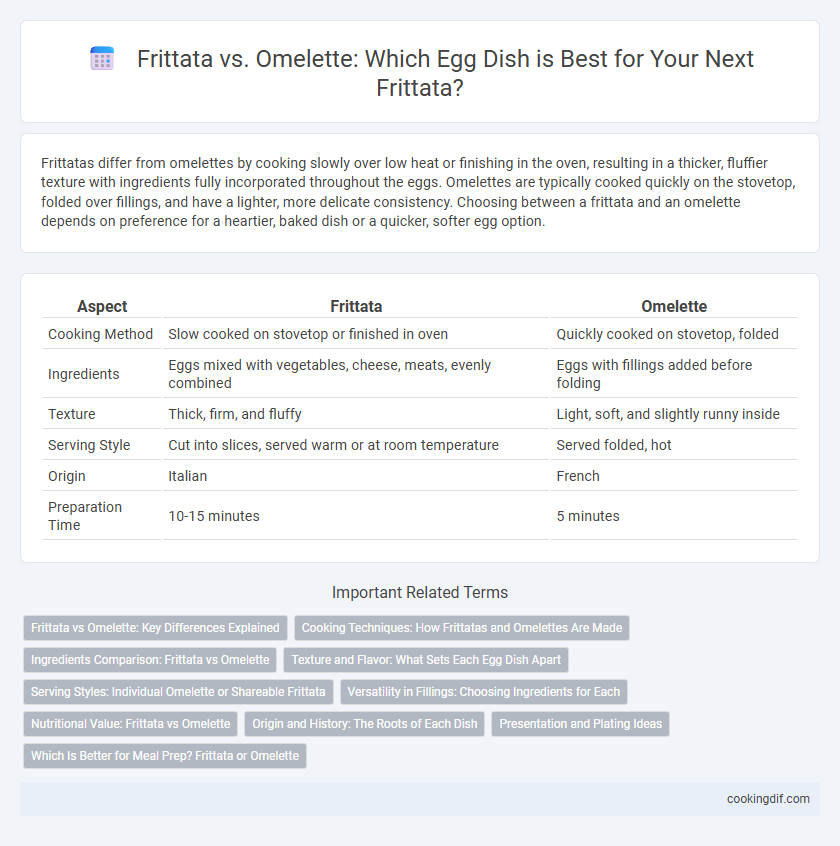Frittatas differ from omelettes by cooking slowly over low heat or finishing in the oven, resulting in a thicker, fluffier texture with ingredients fully incorporated throughout the eggs. Omelettes are typically cooked quickly on the stovetop, folded over fillings, and have a lighter, more delicate consistency. Choosing between a frittata and an omelette depends on preference for a heartier, baked dish or a quicker, softer egg option.
Table of Comparison
| Aspect | Frittata | Omelette |
|---|---|---|
| Cooking Method | Slow cooked on stovetop or finished in oven | Quickly cooked on stovetop, folded |
| Ingredients | Eggs mixed with vegetables, cheese, meats, evenly combined | Eggs with fillings added before folding |
| Texture | Thick, firm, and fluffy | Light, soft, and slightly runny inside |
| Serving Style | Cut into slices, served warm or at room temperature | Served folded, hot |
| Origin | Italian | French |
| Preparation Time | 10-15 minutes | 5 minutes |
Frittata vs Omelette: Key Differences Explained
Frittata and omelette differ primarily in cooking methods and texture; a frittata is cooked slowly over low heat and finished in the oven, resulting in a thicker, more custard-like dish, while an omelette is cooked quickly in a pan and folded for a softer, fluffier texture. Frittatas often include mixed ingredients like vegetables, cheeses, and meats distributed evenly throughout, whereas omelettes typically have fillings folded inside. The frittata's open, round shape contrasts with the omelette's folded, half-moon form, reflecting their unique preparation styles.
Cooking Techniques: How Frittatas and Omelettes Are Made
Frittatas are cooked slowly over low heat or finished in the oven, allowing eggs to set uniformly with added ingredients mixed in, creating a thick, open-faced dish. Omelettes require quick cooking over higher heat, with ingredients folded inside the eggs before serving, resulting in a soft, folded structure. The frittata's technique emphasizes gradual cooking and even heat, while omelettes depend on speed and precise folding for texture.
Ingredients Comparison: Frittata vs Omelette
Frittata incorporates a broader variety of ingredients mixed directly into the eggs, such as vegetables, cheeses, meats, and herbs, creating a denser and more filling dish. Omelette typically contains fewer ingredients, often limited to fillings like cheese, ham, or mushrooms folded inside the cooked eggs. The frittata's ingredients are fully integrated and cooked slowly, whereas the omelette's fillings are added after the eggs begin to set, resulting in different textures and flavor distributions.
Texture and Flavor: What Sets Each Egg Dish Apart
Frittatas have a dense and custardy texture created by slow cooking and even baking, resulting in rich, layered flavors from ingredients fully integrated into the eggs. Omelettes offer a lighter, fluffier texture due to rapid cooking and folding, highlighting distinct, sharper flavors of individual fillings. The combination of texture and flavor differences makes frittatas heartier and omelettes more delicate in taste and mouthfeel.
Serving Styles: Individual Omelette or Shareable Frittata
Frittatas are typically baked and served in a large, shareable pan, making them ideal for communal dining and easy portioning at the table. Omelettes are cooked quickly in a skillet and folded, designed as individual servings customized with specific fillings. The serving style of a frittata encourages sharing and variety, while omelettes offer personalized, single-portion convenience.
Versatility in Fillings: Choosing Ingredients for Each
Frittatas offer greater versatility in fillings compared to omelettes, as they accommodate a wide range of ingredients such as vegetables, cheeses, meats, and herbs evenly distributed throughout the dish. In contrast, omelettes typically fold around a more limited filling quantity, emphasizing a balance between egg and stuffing for a soft texture. This flexibility makes frittatas ideal for incorporating leftovers or variety, enhancing flavor complexity and nutritional content.
Nutritional Value: Frittata vs Omelette
Frittatas typically contain a higher protein content compared to omelettes due to the inclusion of additional ingredients like vegetables, cheese, and meats mixed directly into the eggs. Omelettes often have fewer calories and lower fat levels since fillings are usually added after the eggs are cooked, resulting in less incorporation of fats. Both dishes provide essential nutrients such as vitamins A, D, and B12, but the frittata's added ingredients contribute to a more nutrient-dense meal overall.
Origin and History: The Roots of Each Dish
Frittatas originate from Italy, with roots tracing back to the Roman Empire where eggs mixed with various ingredients were cooked slowly to create a hearty meal. Omelettes have a more debated origin but are often credited to French cuisine, evolving as a quick, pan-fried egg dish that emphasizes speed and simplicity. Both dishes showcase regional culinary traditions that highlight eggs as a versatile, protein-rich staple in Mediterranean and European food culture.
Presentation and Plating Ideas
Frittatas offer a visually appealing presentation with their thick, pie-like structure that can be sliced into wedges, making them ideal for plated servings or buffet-style display. Omelettes, with their folded, delicate texture, lend themselves to elegant individual plating, often garnished with fresh herbs or a drizzle of sauce for a refined look. Utilizing colorful vegetables, cheeses, and herbs in both dishes enhances vibrancy, while frittatas benefit from presentation in a cast iron skillet or ceramic dish to emphasize a rustic charm.
Which Is Better for Meal Prep? Frittata or Omelette
Frittatas offer superior meal prep benefits due to their ability to be baked in large batches and stored for several days without losing texture or flavor. Omelettes, while quicker to cook, are best enjoyed fresh and tend to become soggy or rubbery when reheated. For efficient portion control and versatility in reheating, frittatas provide a more practical and convenient option.
Frittata vs Omelette for egg dish Infographic

 cookingdif.com
cookingdif.com